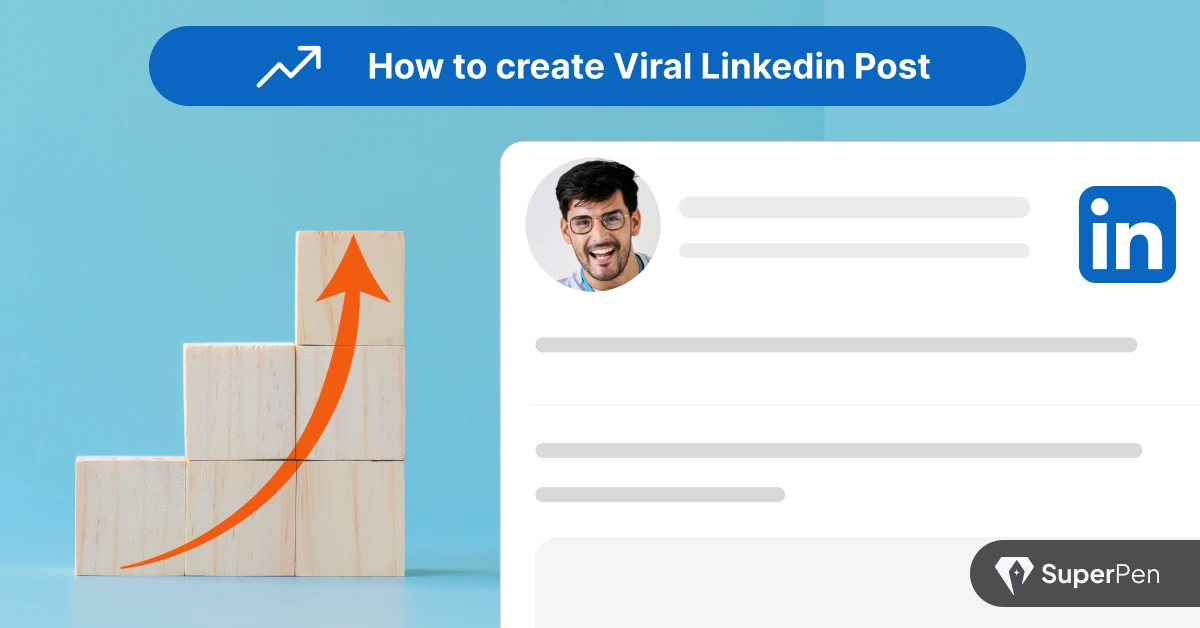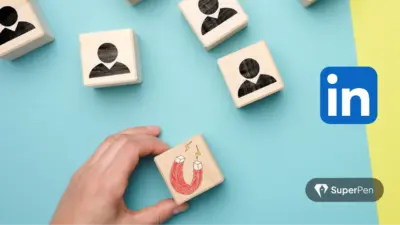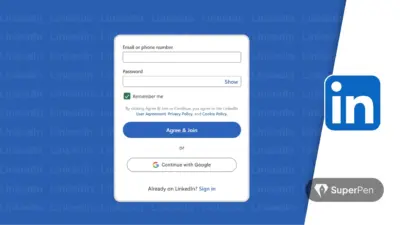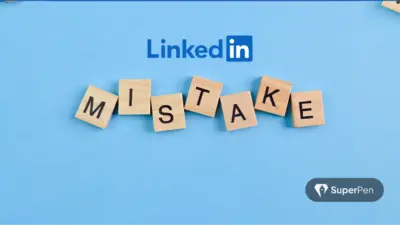Table of Contents
Ever wonder why some LinkedIn posts blow up while yours gets 3 likes and a polite comment from your college roommate?
You’re not alone.
In 2025, LinkedIn isn’t just a resume dump. It’s where founders land investors, consultants find clients, and jobseekers become thought leaders. Going viral isn’t just about reach – it’s about reputation. And if you’re serious about building a brand, you need to master the post.
This guide breaks down exactly how to write posts that actually go viral on LinkedIn today-no gimmicks, no guesswork.
What Actually Makes a LinkedIn Post Go Viral in 2025?

The algorithm’s evolved. But human psychology hasn’t.
At the core, five elements fuel virality:
- Hook: Your first 1–2 lines should slap. Period.
- Clarity: Posts need white space, structure, and rhythm. Nobody reads walls of text.
- Timing: Mornings ( 8:00 – 10:00 AM) and afternoons (12:00 – 1:00 PM), Tuesday, Wednesday, and Thursday work best.
- Engagement Signals: Comments > likes. Responding to every comment matters.
- Value: If your post doesn’t help, teach, provoke, or entertain – it flops.
Now let’s break that down into something you can use today.
The Anatomy of a Viral Post
1. The Scroll-Stopping Hook
In 2025, your first 2 lines are your only chance to stop someone mid-scroll.
Here’s what works:
- 🚫 Contrarian Opinion: “Stop hiring for culture fit. It’s killing your diversity.”
- 😲 Shock Value: “I almost shut down my business last week.”
- ✅ Tactical Lists: “3 AI tools I use to write viral LinkedIn posts.”
- 💔 Relatable Pain: “You spent 30 minutes writing a post. It got 3 likes.”
- 👀 Curiosity Teaser: “This post got 150 DMs. Here’s why.”
Inspired by Chris Donnelly’s and Alex Hormozi’s hooks, these frameworks convert attention into interest.
🔗 More examples here → How to Write Hooks That Work
2. Scannable Structure
Use:
- Short paragraphs (2–3 lines max)
- Line breaks
- Bullet points and lists
- Emojis (sparingly)
- Bold headers in carousels
Think mobile-first. Your post needs to breathe on a tiny screen.
3. Add a Human Element
People don’t connect with perfection. They connect with realness.
Viral posts share:
- Raw stories of failure (not just polished wins)
- Lessons from personal experiences
- Behind-the-scenes snapshots
Example: “We hit 10K users. But what we don’t talk about? The 5 things we did that didn’t work at all.”
4. Use High-Impact Formats
Different post types have different engagement rates:
| Format | Avg Engagement | Use For |
| Text Only | 1.5–2.5% | Quick updates, thoughts |
| Image Posts | 2–3% | Visual storytelling |
| Carousels | 3–4% | Step-by-step, “how to” posts |
| Video Posts | 3.5–4.5% | Behind-the-scenes, mini-lectures |
| Polls | High comments | Spark debate |
Want your post to blow up? Try mixing it up formats – carousels and polls work like magic.
5. Nail the CTA (Without Being Cringe)
No one wants to be sold to.
But a well-placed CTA drives engagement.
Try:
- “What do you think?”
- “Which of these have you tried?”
- “Tag someone who needs this.”
Just don’t end with “Follow me for more.” People follow value, not commands.
Real Examples of Viral Posts That Worked in 2025
Example 1: The Real-World Eye-Opener
Hook: “Yesterday’s rain exposed a scam I had no clue about.”
Body: A raw, emotional story about illegal tree cutting in India. It’s not just storytelling-it’s activism. The post called out shady practices, exposed loopholes, and ended with a heartfelt plea to spread awareness.
Engagement: 1.6K+ likes, 40 reposts
Why it worked: Deeply human. Specific. Courageous. It educated while evoking emotion-and people felt it.
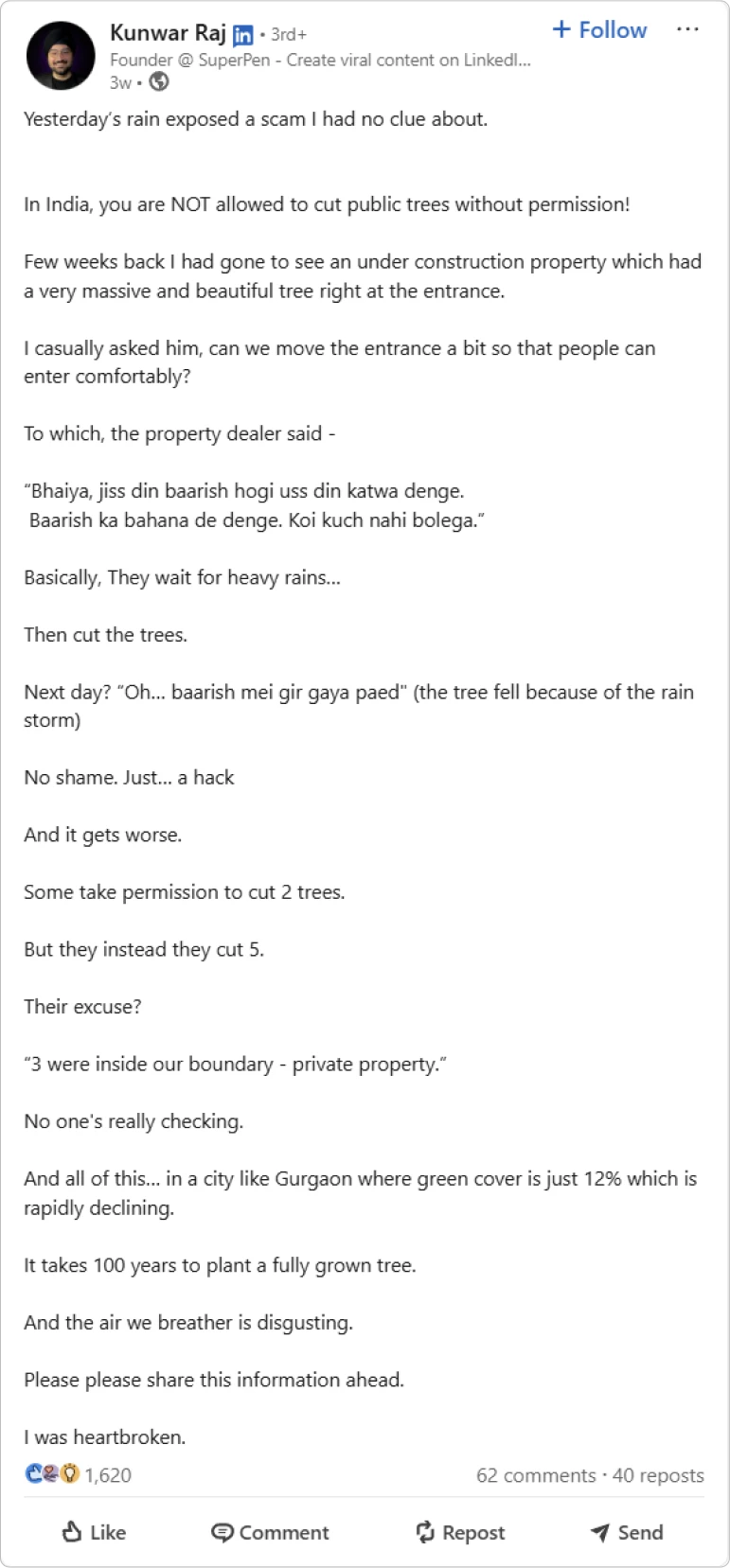
🔥 Example 2: The Relatable One-Liner
Hook: “Is it too late to start?”
Body: A minimalist post that tapped into a universal fear-missing the boat. With just a few words and a visual, it sparked thousands of comments from people sharing their own stories of late starts and second chances.
Engagement: 2.6K+ likes, 47 comments
Why it worked: Simplicity. Relatability. Emotional resonance. It proved that sometimes, less is more.
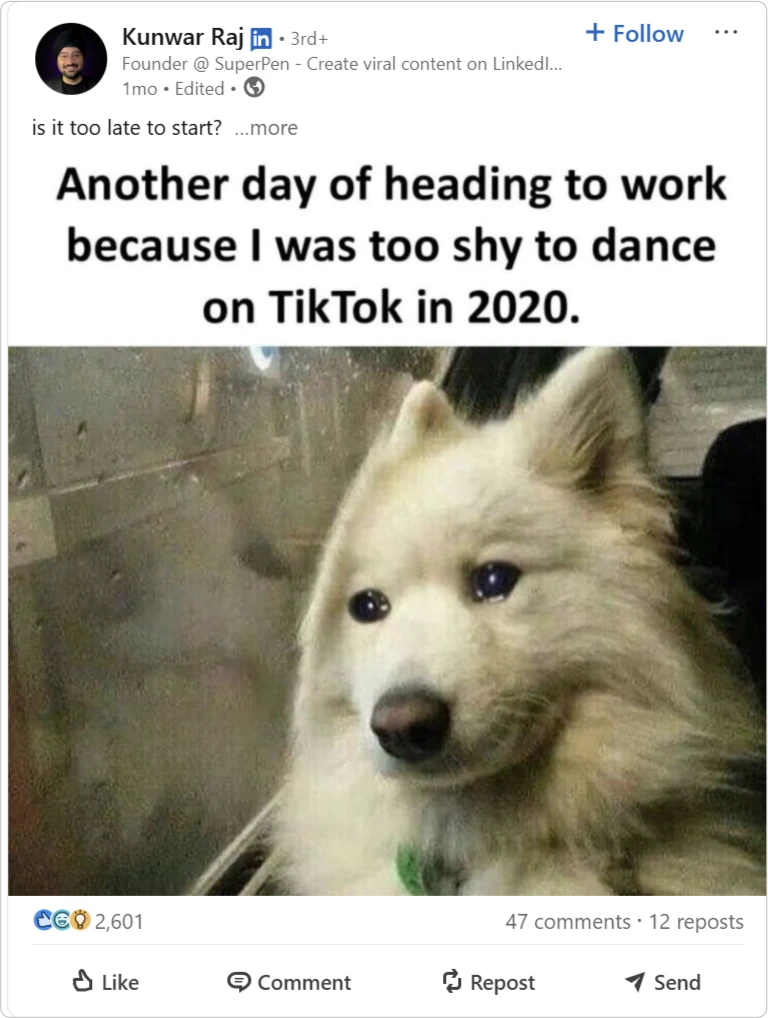
Example 3: The Sharp Social Commentary
Hook: “Men will start a company… get other men as co-founders… and this Saturday, they’ll ask their male designer to make a Women’s Day post.”
Body: A biting critique of performative diversity. This post didn’t name names-but it didn’t have to. It struck a nerve across LinkedIn, calling out hypocrisy in hiring, branding, and corporate culture.
Engagement: 1.5 K+ likes, 80+ comments, heavy shares across.
Why it worked: Bold. Specific. Uncomfortably true. It wasn’t a rant – it was a mirror. Posts like this start real conversations, not just collect claps.
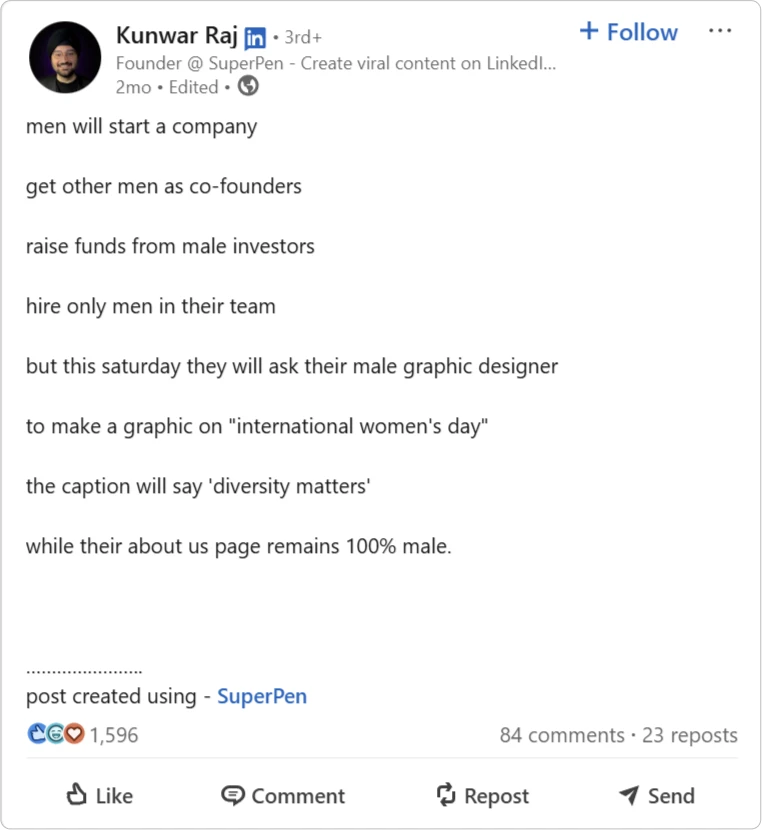
Example 4: The Satirical Truth Bomb
Hook: “Men woke up one day, realised being an assistant is too feminine, renamed it to founder’s office and got away with it.”
Body: A sharp, satirical take on gendered job titles and corporate rebranding. This post humorously critiqued how certain roles are rebranded to sound more prestigious, often masking underlying biases.
Engagement: 5,965 likes, 173 comments
Why it worked: It combined wit with a critical lens on workplace culture, sparking conversations about gender perceptions in professional titles.
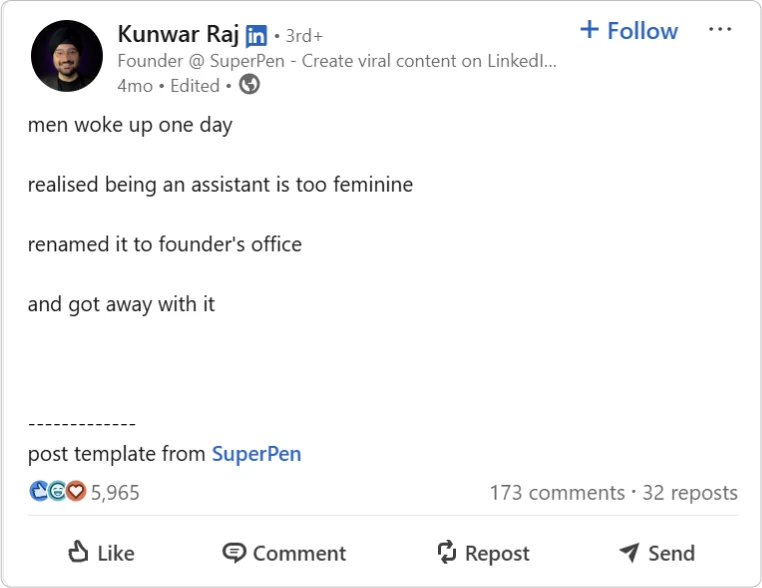
Bonus: Post Like a Pro (Even Without LinkedIn Premium)
LinkedIn Premium isn’t required to build authority. In fact, most top creators grew organically by creating content that pulled people in.
For tools that make this easier, consider SuperPen – it gives you access to 8M+ viral post examples, AI writing tools, and a scheduler built for LinkedIn.
🔗 Read: Tired of LinkedIn Premium? Here’s What Actually Works
Final Thoughts
You don’t need a million followers to go viral.
You need:
- A bold voice
- A repeatable format
- A system you can show up with consistently
So next time you sit down to write a LinkedIn post, ask:
Would you stop to read it?
If not – rewrite your hook, simplify your structure, and give us something real.
Your next post could be the one that changes everything.
Frequently Asked Questions
Q1: How long should my LinkedIn post be to actually get attention?
Stick to around 150 to 300 words. That’s long enough to make a point, tell a quick story, or share a valuable insight-without overwhelming your reader. People scroll fast on LinkedIn, so keep it tight, clear, and punchy.
Q2: What kind of content works best on LinkedIn these days?
Think of content that either teaches, resonates, or sparks a conversation. Personal stories that feel honest, insights backed by data, helpful career tips, and takes on what’s happening in your industry all tend to do really well. Just ask yourself – would you stop to read this in your feed?
Q3: Should I bother using hashtags, or are they just fluff?
Hashtags are still worth it-as long as you don’t overdo it. Use 3 to 5 relevant hashtags that actually connect with your niche or audience. They help your post get discovered beyond your immediate network, especially by people following those tags.
Q4: How do I know if my post is actually performing well?
Head to LinkedIn’s analytics dashboard (you’ll find it on each post). It shows you views, likes, comments, shares, and even what job titles and locations your viewers are from. Watch which posts drive more engagement-and build on what’s working.
Q5: Is it okay to repost old content on LinkedIn?
Definitely. Most of your audience didn’t see it the first time anyway. Just make sure the content still feels relevant-and maybe update the hook or add a new angle. Reposting isn’t lazy if it brings fresh value to the table.


